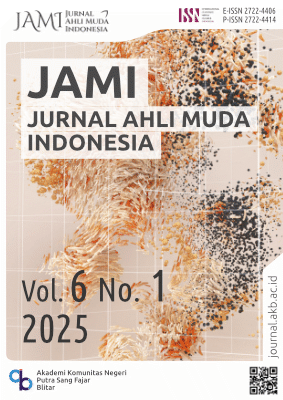Pemodelan Prediksi Penjualan dan Persediaan dengan RapidMiner beserta Pengelompokan Kategori untuk Mempermudah Perencanaan Stok dan Pengambilan Keputusan Bisnis
 Abstract views: 176
,
Abstract views: 176
,
 PDF downloads: 164
PDF downloads: 164
Abstract
Tujuan. Prediksi penjualan dan persediaan adalah upaya penting untuk mengantisipasi permintaan konsumen di masa depan. Hal ini sangat penting untuk perencanaan strategi penjualan jangka panjang, yang didasarkan pada analisis data penjualan atau permintaan dari periode sebelumnya. Melalui penelitian ini, UMKM dapat membuat keputusan yang lebih tepat. Tujuan utama dari penelitian ini adalah untuk memprediksi penjualan dan persediaan dengan akurasi tinggi.
Material dan Metode. Metodologi penelitian yang digunakan haruslah tepat. Penelitian ini dilakukan menggunakan perangkat lunak Rapidminer versi 10.3, dengan data penjualan dan persediaan dari tahun 2019 hingga 2024, serta menggunakan metode Naive Bayes.
Hasil. Hasil penelitian menunjukkan bahwa akurasi prediksi penjualan mencapai 84,62% dan akurasi prediksi persediaan sebesar 83,33%. Studi ini menunjukkan bahwa prediksi yang dihasilkan cenderung konsisten dengan data aktual.
Kesimpulan. Berdasarkan hasil ini, UMKM Keripik Assri dapat lebih yakin dalam perencanaan stok dan strategi penjualan untuk kategori "Rendah" dan "Tinggi".
Downloads
References
Amalia, Y. R., & others. (2018). Penerapan Data Mining Untuk Prediksi Penjualan Produk Elektronik Terlaris Menggunakan Metode K-Nearest Neighbor (Studi Kasus: PT. Bintang Multi Sarana Palembang). UIN RADEN FATAH PALEMBANG.
Ayuningtyas, N., R, N., & M. Basysyar, F. (2022). Penerapan Data Mining pada Penjualan Produk MS Glow Menggunakan Metode Naive Bayes untuk Strategi Pemasaran. Jurnal Accounting Information System (AIMS), 5(2), 157–166. https://doi.org/10.32627/aims.v5i2.503
Budi Harijanto, Yuri Ariyanto, & Luthfia Miftahurroifa. (2018). PENERAPAN ALGORITMA NAÏVE BAYES UNTUK KLASIFIKASI RETENSI ARSIP. Jurnal Informatika Polinema, 4(2), 155. https://doi.org/10.33795/jip.v4i2.159
Daniati, E., & Nugroho, A. (2016). K-Means clustering with Decision Support System using SAW: Determining thesis topic. 2016 6th IEEE International Conference on Control System, Computing and Engineering (ICCSCE), 326–331. https://doi.org/10.1109/ICCSCE.2016.7893593
Daniati, E., & Utama, H. (2019). Clustering K Means for Criteria Weighting With Improvement Result of Alternative Decisions Using SAW and TOPSIS. 2019 4th International Conference on Information Technology, Information Systems and Electrical Engineering (ICITISEE), 73–78. https://doi.org/10.1109/ICITISEE48480.2019.9003858
Darmawan, A., Kustian, N., & Rahayu, W. (2018). Implementasi Data Mining Menggunakan Model SVM untuk Prediksi Kepuasan Pengunjung Taman Tabebuya. STRING (Satuan Tulisan Riset Dan Inovasi Teknologi), 2(3), 299. https://doi.org/10.30998/string.v2i3.2439
Dewi, S. P., Nurwati, N., & Rahayu, E. (2022). Penerapan Data Mining Untuk Prediksi Penjualan Produk Terlaris Menggunakan Metode K-Nearest Neighbor. Building of Informatics, Technology and Science (BITS), 3(4), 639–648. https://doi.org/10.47065/bits.v3i4.1408
Dharmawan, M. A., Indriati, R., & Sucipto, S. (2019). Implementasi Sistem Informasi Tugas Akhir Menggunakan Metode Classic Life Cycle. Prosiding SEMNAS INOTEK (Seminar Nasional Inovasi Teknologi), 3(1), 151–154.
Hastuti, P., & Ismayanti, D. (2019). ANALISIS FORECASTING PENJUALAN PRODUK HANDPHONE MERK SAMSUNG DI COUNTER SAMSUNG Q MALL BANJARBARU. Jurnal Ilmiah Ekonomi Bisnis, 5(1). https://doi.org/10.35972/jieb.v5i1.254
Irfan, M., Ayuningtias, L. P., & Jumadi, J. (2018). ANALISA PERBANDINGAN LOGIC FUZZY METODE TSUKAMOTO, SUGENO, DAN MAMDANI ( STUDI KASUS : PREDIKSI JUMLAH PENDAFTAR MAHASISWA BARU FAKULTAS SAINS DAN TEKNOLOGI UIN SUNAN GUNUNG DJATI BANDUNG). JURNAL TEKNIK INFORMATIKA, 10(1), 9–16. https://doi.org/10.15408/jti.v10i1.6810
KHASANAH, E. R. A. R. (2017). PENERAPAN JARINGAN SYARAF TIRUAN UNTUK MEMPREDIKSI PENJUALAN JENANG (STUDI PADA HOME INDUSTRI JENANG MIRAH KECAMATAN JETIS KABUPATEN PONOROGO). Universitas Muhammadiyah Ponorogo.
Loelianto, I., Thayf, Moh. S. S., & Angriani, H. (2020). IMPLEMENTASI TEORI NAIVE BAYES DALAM KLASIFIKASI CALON MAHASISWA BARU STMIK KHARISMA MAKASSAR. SINTECH (Science and Information Technology) Journal, 3(2), 110–117. https://doi.org/10.31598/sintechjournal.v3i2.651
Ning, B., Junwei, W., & Feng, H. (2019). Spam message classification based on the Naïve Bayes classification algorithm. IAENG International Journal of Computer Science, 46(1), 46–53.
Nurdiawan, O., & Salim, N. (2018). Penerapan Data Mining Pada Penjualan Barang Menggunakan Metode Metode Naive Bayes Classifier Untuk Optimasi Strategi Pemasaran. Jurnal Teknologi Informasi Dan Komunikasi, 13(1), 84–95.
Pradikdo, A. C., & Ristyawan, A. (2018). MODEL KLASIFIKASI ABSTRAK SKRIPSI MENGGUNAKAN TEXT MINING UNTUK PENGKATEGORIAN SKRIPSI SESUAI BIDANG KAJIAN. Simetris: Jurnal Teknik Mesin, Elektro Dan Ilmu Komputer, 9(2), 1091–1098. https://doi.org/10.24176/simet.v9i2.2513
Purwanto, A., & Darmadi, E. A. (2018). Perbandingan Minat Siswa Smu Pada Metode Klasifikasi Menggunakan 5 Algoritma. IKRA-ITH INFORMATIKA: Jurnal Komputer Dan Informatika, 2(1), 43–47.
Sucipto, S. (2017). Perancangan Active Database System pada Sistem Informasi Pelayanan Harga Pasar. INTENSIF, 1(1), 35. https://doi.org/10.29407/intensif.v1i1.562
Sugiyono, D. (2010). Metode penelitian kuatintatif, kualitatif dan R & D/Sugiyono. Bandung: Alfabeta, 15, 1–332.
Taufik Hidayat, M., Suarna, N., & Rahaningsih, N. (2023). IMPLEMENTASI ALGORITMA NAÏVE BAYES UNTUK PREDIKSI PERSEDIAAN BARANG PT. DILMONI CITRA MEBEL INDONESIA. JATI (Jurnal Mahasiswa Teknik Informatika), 7(1), 693–699. https://doi.org/10.36040/jati.v7i1.6310
Yam, J. H., & Taufik, R. (2021). Hipotesis Penelitian Kuantitatif. Perspektif : Jurnal Ilmu Administrasi, 3(2), 96–102. https://doi.org/10.33592/perspektif.v3i2.1540
Copyright (c) 2025 Akmal Hisyam Pradhana, Achmad Ali Firmansyah , Bifadhlillah Marsheila Islami

This work is licensed under a Creative Commons Attribution-ShareAlike 4.0 International License.
Authors who publish with this journal agree to the following terms:
1. Copyright on any article is retained by the author(s).
2. The author grants the journal, right of first publication with the work simultaneously licensed under a Creative Commons Attribution License that allows others to share the work with an acknowledgment of the work’s authorship and initial publication in this journal.
3. Authors are able to enter into separate, additional contractual arrangements for the non-exclusive distribution of the journal’s published version of the work (e.g., post it to an institutional repository or publish it in a book), with an acknowledgment of its initial publication in this journal.
4. Authors are permitted and encouraged to post their work online (e.g., in institutional repositories or on their website) prior to and during the submission process, as it can lead to productive exchanges, as well as earlier and greater citation of published work.
5. The article and any associated published material is distributed under the Creative Commons Attribution-ShareAlike 4.0 International License




